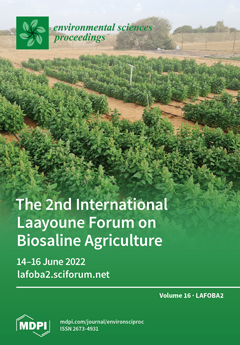Salinity is becoming a serious threat to global food security, as it can significantly reduce crop yields and irreversibly damage soil fertility. Moreover, this problem is currently exacerbated by the impact of climate change, especially in drylands. Hence, introducing and adapting salinity-tolerant species,
[...] Read more.
Salinity is becoming a serious threat to global food security, as it can significantly reduce crop yields and irreversibly damage soil fertility. Moreover, this problem is currently exacerbated by the impact of climate change, especially in drylands. Hence, introducing and adapting salinity-tolerant species, such as quinoa (
Chenopodium quinoa, Willd.), could be among the ways to enhance the value of saline land, increasing its productivity and improving small farmers’ income in rural areas. Quinoa, originally cultivated in the Andean region, has gained more attention throughout the Mediterranean region because it yields well even in marginal soils. It is also considered one of the world’s healthiest foods, as its grains contain a balanced composition of minerals, vitamins, dietary fiber, fats, and high-quality, gluten-free proteins, with a balanced profile of all amino acids. In Morocco, quinoa was introduced in 2000, but its expansion is still limited to certain regions. In Eastern Morocco, for the first time, an experiment was carried out in 2019–2020 aiming to assess the response of five quinoa cultivars (INIA-420 Negra, Titicaca, Puno, ICBA-Q4 and ICBA-Q5) to saline irrigation. For this, we used two levels of water irrigation salinity: 1.50 dS.m
−1 as a no-salt control from Tagma’s source in Tafoghalt village and 10.5 dS.m
−1 as salt treatment from local water drilling. Agronomic parameters, mainly dry matter, leaf area, grain yield and 1000-kernel weight, were measured to assess quinoa cultivars’ responses to saline irrigation. Statistical analysis revealed that all investigated parameters were significantly affected by salinity, quinoa variety and their interaction (
p < 0.05). Furthermore, significant differences in terms of salinity tolerance among the five quinoa cultivars were observed, with the highest (2.17 t.ha
−1) and lowest (0.33 t.ha
−1) yields recorded for ICBA-Q5 and INIA-420 Negra, respectively. However, the same varieties tested previously in Southern Morocco tolerated a higher level of salinity (12 dS.m
−1). We assume that other factors interfered with salinity and variety, such as the sowing date, which was relatively late and exposed the flowering and grain filling stages to high heat in May and June.
Full article



